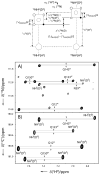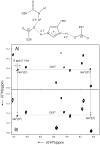Hydrogen-bond detection, configuration assignment and rotamer correction of side-chain amides in large proteins by NMR spectroscopy through protium/deuterium isotope effects
- PMID: 18973166
- PMCID: PMC3018730
- DOI: 10.1002/cbic.200800467
Hydrogen-bond detection, configuration assignment and rotamer correction of side-chain amides in large proteins by NMR spectroscopy through protium/deuterium isotope effects
Abstract
The configuration and hydrogen-bonding network of side-chain amides in a 35 kDa protein were determined by measuring differential and trans-hydrogen-bond H/D isotope effects by using the isotopomer-selective (IS)-TROSY technique, which leads to a reliable recognition and correction of erroneous rotamers that are frequently found in protein structures. First, the differential two-bond isotope effects on carbonyl (13)C' shifts, which are defined as Delta(2)Delta(13)C'(ND) = (2)Delta(13)C'(ND(E))-(2)Delta(13)C'(ND(Z)), provide a reliable means for the configuration assignment for side-chain amides, because environmental effects (hydrogen bonds and charges, etc.) are greatly attenuated over the two bonds that separate the carbon and hydrogen atoms, and the isotope effects fall into a narrow range of positive values. Second and more importantly, the significant variations in the differential one-bond isotope effects on (15)N chemical shifts, which are defined as Delta(1)Delta(15)N(D) = (1)Delta(15)N(D(E))-(1)Delta(15)N(D(Z)) can be correlated with hydrogen-bonding interactions, particularly those involving charged acceptors. The differential one-bond isotope effects are additive, with major contributions from intrinsic differential conjugative interactions between the E and Z configurations, H-bonding interactions, and charge effects. Furthermore, the pattern of trans-H-bond H/D isotope effects can be mapped onto more complicated hydrogen-bonding networks that involve bifurcated hydrogen-bonds. Third, the correlations between Delta(1)Delta(15)N(D) and hydrogen-bonding interactions afford an effective means for the correction of erroneous rotamer assignments of side-chain amides. Rotamer correction by differential isotope effects is not only robust, but also simple and can be applied to large proteins.
Figures






Similar articles
-
Deuterium isotope effects on 15N backbone chemical shifts in proteins.J Biomol NMR. 2009 Jul;44(3):119-26. doi: 10.1007/s10858-009-9316-0. Epub 2009 May 20. J Biomol NMR. 2009. PMID: 19455282 Free PMC article.
-
NMR detection and conformational dependence of two, three, and four-bond isotope shifts due to deuteration of backbone amides.J Biomol NMR. 2023 Jun;77(3):93-109. doi: 10.1007/s10858-023-00414-7. Epub 2023 Apr 24. J Biomol NMR. 2023. PMID: 37093339 Free PMC article.
-
TROSY of side-chain amides in large proteins.J Magn Reson. 2007 Jun;186(2):319-26. doi: 10.1016/j.jmr.2007.02.008. Epub 2007 Feb 14. J Magn Reson. 2007. PMID: 17347000 Free PMC article.
-
Isotope effects on chemical shifts in the study of hydrogen bonded biological systems.Prog Nucl Magn Reson Spectrosc. 2020 Oct-Dec;120-121:109-117. doi: 10.1016/j.pnmrs.2020.08.001. Epub 2020 Aug 29. Prog Nucl Magn Reson Spectrosc. 2020. PMID: 33198966 Review.
-
A Spectroscopic Overview of Intramolecular Hydrogen Bonds of NH…O,S,N Type.Molecules. 2021 Apr 21;26(9):2409. doi: 10.3390/molecules26092409. Molecules. 2021. PMID: 33919132 Free PMC article. Review.
Cited by
-
The pKa values of the catalytic residues in the retaining glycoside hydrolase T26H mutant of T4 lysozyme.Protein Sci. 2019 Mar;28(3):620-632. doi: 10.1002/pro.3562. Epub 2019 Jan 12. Protein Sci. 2019. PMID: 30537432 Free PMC article.
-
A glutamine-based single α-helix scaffold to target globular proteins.Nat Commun. 2022 Nov 18;13(1):7073. doi: 10.1038/s41467-022-34793-6. Nat Commun. 2022. PMID: 36400768 Free PMC article.
-
Deuterium isotope effects on 15N backbone chemical shifts in proteins.J Biomol NMR. 2009 Jul;44(3):119-26. doi: 10.1007/s10858-009-9316-0. Epub 2009 May 20. J Biomol NMR. 2009. PMID: 19455282 Free PMC article.
-
Accurate measurements of the effects of deuteration at backbone amide positions on the chemical shifts of ¹⁵N, ¹³Cα, ¹³Cβ, ¹³CO and ¹Hα nuclei in proteins.J Biomol NMR. 2013 Jun;56(2):169-82. doi: 10.1007/s10858-013-9733-y. Epub 2013 Apr 24. J Biomol NMR. 2013. PMID: 23612994
-
Selective (15)N-labeling of the side-chain amide groups of asparagine and glutamine for applications in paramagnetic NMR spectroscopy.J Biomol NMR. 2014 Aug;59(4):251-61. doi: 10.1007/s10858-014-9844-0. Epub 2014 Jul 8. J Biomol NMR. 2014. PMID: 25002097
References
-
- Creighton TE. Proteins: Structure and Molecular Properties. 2. Freeman, W. H. and Company; New York: 1993.
-
- Word JM, Lovell SC, Richardson JS, Richardson DC. J Mol Biol. 1999;285:1735–1747. - PubMed
-
- Weichenberger CX, Sippl MJ. Bioinformatics. 2006;22:1397–1398. - PubMed
-
- Hansen PE. Magn Reson Chem. 2000;38:1–10.
Publication types
MeSH terms
Substances
Grants and funding
LinkOut - more resources
Full Text Sources
Molecular Biology Databases

